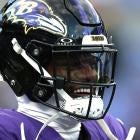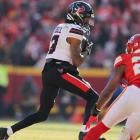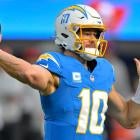All the way back in Week 1, Sam Bradford led the Minnesota Vikings to a dominating win over the New Orleans Saints. Minnesota's speedy and powerful defense smothered the usually-explosive New Orleans offense, while the Saints allowed Bradford to tear them apart through the air with a 346-yard, three-touchdown masterpiece.
This game was the first sign of great things to come for the Vikes, as they would use it as a springboard to a 13-3 season and the No. 2 seed in the NFC. Despite Bradford's injury and the transition to Case Keenum, the offense kept humming along. Despite Dalvin Cook's torn ACL, the offense kept humming along. Adam Thielen blossomed into one of football's best receivers. Stefon Diggs continued his progress. Keenum came out of nowhere to be one of the best quarterbacks in the NFC. And Mike Zimmer's defense held up its end of the bargain, shutting teams down both on the ground and through the air.
That Week 1 game was less of a harbinger of things to come for the Saints. Though they followed it up with another loss to the Patriots the following week -- another loss in which their defense was torn apart -- things soon turned around entirely. New Orleans' discovery of both a powerful running game and a top-10 defense propelled the Saints back into the playoffs for the first time in years. Drew Brees no longer had to carry the entire team on his right shoulder, and the Saints were better off for it.
Both of these teams have come a long way and changed a whole lot since they last met back in their season-opener. Can the Saints get revenge for their Week 1 loss? We'll find out on Sunday afternoon.
How to Watch, stream
Who: Saints vs. Vikings
Where: U.S. Bank Stadium, Minneapolis
When: Sunday, Jan. 14, 4:40 p.m. ET
TV: FOX
Streaming: fuboTV (Try for free)
Saints' newfound balance makes them tough to beat
Prior to the start of the 2017 season, we used this space to write about the lack of success had by "unbalanced" teams that performed significantly better on one side of the ball than the other.
Since the NFL expanded to 32 teams and slotted them into the current eight-division format back in 2002, there have been 17 occasions where a team finished in the top-10 in both scoring and offensive DVOA, as well as the bottom-10 in both points allowed and defensive DVOA. The combined record of those 17 teams was 139-132-1, and that's despite the fact that four of the 17 (2004 Packers, 2006 Colts, 2010 Colts, 2016 Falcons) managed to win double-digit games. The other 13 squads managed a combined record of just 96-111-1, dropping the overall winning percentage for the group from 0.513, or an 8.2 win average, to 0.464, or a 7.4 win average.
All four of those aforementioned teams that managed double-digit victories finished inside the top-six in scoring and offensive DVOA, and outside the bottom-three in points allowed and defensive DVOA. In other words, they had to have truly elite offenses and bad but not quite abominable defenses in order to experience success.
The 2014 Saints, 2015 Saints, AND 2016 Saints all belonged to that group of teams. It should come as no surprise that each of those three teams finished the season with a 7-9 record -- pretty much exactly the average of the 13 top-10 offense/bottom-10 defense teams mentioned in the paragraph above.
Coming into this season, it sure seemed like the Saints would be headed for that territory yet again. After all, the Saints had ranked in the bottom-two in defensive DVOA in each of the last three seasons, and they seemingly did not make a ton of personnel upgrades during the offseason. They drafted four defensive players, but two were defensive backs -- a position at which players mostly tend to struggle as first-year players; and the other two were backup pass rushers. Their major signings were Alex Okafor, A.J. Klein ... and that's it.
Of course, we all know what happened. Those rookies -- especially the defensive backs, Marshon Lattimore and Marcus Williams -- turned out to be instant-impact players. Second-year undrafted free-agent Ken Crawley turned out to be an incredible find. Players like Vonn Bell, Kenny Vaccaro, P.J. Williams, and more stepped up to play important roles in the secondary. Sheldon Rankins had a breakout Year 2. Manti Te'o turned out to be a nice signing at the second level. Unknowns like David Onyemata and Tyeler Davison turned out to be important contributors. And Cameron Jordan went from "one of the most underrated players in the league" to "inner-circle Defensive Player of the Year candidate."
Add it all up and the Saints had a top-10 defense, one that was especially stingy against the pass. And it helped them achieve not just offense-defense balance, but balance within their offense as well. For the first time since 2009, Drew Brees threw less than 625 passes in a season. He averaged 656 attempts over the last seven years; he had just 536 this season.
The combination of Mark Ingram and Alvin Kamara became the best 1-2 running back punch anybody has seen in years. Both players exceeded 1,500 total yards, and they combined for 26 total touchdowns. The Saints leaned on them early and often both on the ground and through the air. Combined with the Michael Thomas-led air game, the Saints were as impossible to stop as ever. And they still are.
Can the Vikings turn weaknesses into strengths?
On the surface, the Vikings appear to be a team lacking in any significant weaknesses. Like the Saints, they were one of five teams that ranked inside the top-10 in DVOA on both sides of the ball. Minnesota finished the season fifth in offensive DVOA and second in defensive DVOA.
Also like the Saints, they were incredibly strong with both the run and the pass on one side of the ball (offense for the Saints, defense for the Vikings), while being somewhat less balanced on the other. The Saints ranked fifth in pass defense DVOA and 23rd against the run. The Vikings ranked third in pass offense DVOA and 18th on the run. Unfortunately, that makes the Vikings somewhat ill-equipped to take advantage of the Saints' one apparent weakness. (If you're not that into more advanced numbers like DVOA, well, the Vikings averaged just 3.9 yards per carry this season. That figure tied for 22nd in the league.)
The Vikings also had another weakness offensively, though. Despite making some upgrades to their offensive line, they still allowed a ton of pressure this season. Keenum was sacked, hit, or hurried on 39.3 percent of his drop backs this season, per Pro Football Focus. Among 29 qualifying quarterbacks, that pressure rate was the third-highest in the league behind only Russell Wilson and Jacoby Brissett.
That's bad news for the Vikes because Keenum, like every other quarterback in the league, sees a significant drop-off in his play when he's under pressure. He recorded a 109.5 passer rating when throwing from a clean pocket this season, compared to just 78.5 when pressured. That's like going from being better than Aaron Rodgers to being worse than Matt Cassel.
The Saints' 35.1 percent pressure rate during the regular season was only slightly above-average, but they did an excellent job of (a) turning their pressure into sacks, where they ranked seventh in the NFL; and (b) taking advantage of opponents' throws when under pressure. New Orleans allowed a perfect 158.3 passer rating under pressure to each of the first two quarterbacks they faced this season (Bradford and Brady), but after that allowed just a 58.9 rating from Week 3 through the wild card round. From Week 12 on, it's been just a 41.3 rating. They've gotten better as the season has gone along.
Keenum has made plenty of plays both under pressure and from a clean pocket this season, and his crop of pass-catchers has performed far better than anyone expected coming into the year. But the Saints have two excellent corners and a pass rush that forces QBs into a ton of mistakes.
Who ya got?
In a matchup of two extremely well-balanced teams, the determining factor is often which team has the best chance of minimizing its own weaknesses. Here, the Saints' weakness is their ability to stop the run. If the Vikings had a better run game, they might be the pick; but alas, they averaged just 3.9 yards per carry this season and ranked 18th in Football Outsiders' run defense DVOA. There are strength vs. strength matchups pretty much everywhere else on the field, and right now, it just seems that the Saints' strengths are greater than those of the Vikings.
Minnesota has home-field advantage, but the game is still indoors, which plays into the Saints' hands. If there was ever a time where New Orleans would be in good position to pull off a road playoff upset, this would be it.
Our prediction: Saints 23, Vikings 20

















